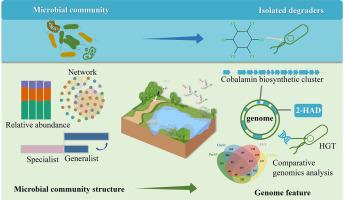当前位置:
X-MOL 学术
›
Water Res.
›
论文详情
Our official English website, www.x-mol.net, welcomes your
feedback! (Note: you will need to create a separate account there.)
Unravelling the processes involved in biodegradation of chlorinated organic pollutant: From microbial community to isolated organohalide degraders
Water Research ( IF 11.4 ) Pub Date : 2024-10-31 , DOI: 10.1016/j.watres.2024.122730 Meng Liu, Xin Su, Jing Yuan, Xueling Yang, Yuxuan Chen, Qianru Xu, Xiaowei Huang, Jianming Xu, Yan He
Water Research ( IF 11.4 ) Pub Date : 2024-10-31 , DOI: 10.1016/j.watres.2024.122730 Meng Liu, Xin Su, Jing Yuan, Xueling Yang, Yuxuan Chen, Qianru Xu, Xiaowei Huang, Jianming Xu, Yan He

|
Hundreds of studies have demonstrated the bioremediation of chlorinated organic pollutants (COPs) in flooded environments. However, the role of specific functional strains in degrading COPs under complex media such as wetlands is still unclear. Here, we focused on the microbial characteristics of COP-polluted sediments, identified the bacteria responsible for degradation and conducted a genomic analysis of these bacteria. Four strains were obtained and identified as Petrimonas sulfuriphila PET, Robertmurraya sp. CYTO, Hungatella sp. CloS1 and Enterococcus avium PseS3, respectively. They were capable of degrading a typical COP, γ-hexachlorocyclohexane (γ-HCH). The residual γ-HCH concentrations were 58.8 % (PET), 45.6 % (CYTO), 60.2 % (CloS1), and 69.3 % (PseS3) of its initial value, respectively. Strain PET, CYTO and CloS1 could degrade γ-HCH to its dehalogenation product chlorobenzene. Each strain harbors genes annotated to the pathway of halogenated organic matter degradation (e.g. 2-haloacid dehalogenase) and cobalamin biosynthesis, which are involved in the degradation of COPs. Comparative genomic analysis of the four strains and other classical organohalide-respiring bacteria (e.g. Dehalococcoides mccartyi and Sulfurospirillum multivorans DSM 12446) showed that they share orthologous clusters related to the cobalamin biosynthetic process (GO:0009236). VB12 was also detected in the culture systems of the four strains, further highlighting the importance of cobalamin in COPs degradation. In the genome of the four strains, some genes were annotated to the halogenated organic matter degradation and cobalamin biosynthesis pathway within horizontal gene transfer (HGT) regions. This further indicated that microorganisms carrying these genes can adapt faster to pollution stress through HGT. Together, these findings revealed the co-evolution mechanism of functional strains and may provide novel insights into improved bioremediation strategies for COP-polluted complex media based on generalist organochlorine-degrading bacteria.
中文翻译:

揭示氯化有机污染物生物降解所涉及的过程:从微生物群落到分离的有机卤化物降解剂
数百项研究表明,在洪水环境中,氯化有机污染物 (COP) 可以进行生物修复。然而,特定功能菌株在湿地等复杂介质下降解 COPs 中的作用尚不清楚。在这里,我们专注于 COP 污染沉积物的微生物特性,确定了导致降解的细菌,并对这些细菌进行了基因组分析。获得 4 个菌株,鉴定为 Petrimonas sulfuriphila PET、Robertmurraya sp. CYTO、Hungatella sp.分别为 CloS1 和鸟肠球菌 PseS3。它们能够降解典型的 COP,γ-六氯环己烷 (γ-HCH)。残留 γ-HCH 浓度分别为其初始值的 58.8 % (PET) 、 45.6 % (CYTO) 、 60.2 % (CloS1) 和 69.3 % (PseS3)。菌株 PET、CYTO 和 CloS1 可将 γ-HCH 降解为其脱卤产物氯苯。每个菌株都含有与卤代有机物降解(例如 2-卤酸脱卤酶)和钴胺素生物合成途径注释的基因,这些基因参与 COP 的降解。四种菌株和其他经典有机卤化物呼吸细菌(例如 Dehalococcoides mccartyi 和 Sulfurospirillum multivorans DSM 12446)的比较基因组分析表明,它们共享与钴胺素生物合成过程相关的直系同源簇 (GO:0009236)。在四种菌株的培养系统中也检测到 VB12,进一步突出了钴胺素在 COPs 降解中的重要性。在四个菌株的基因组中,一些基因被注释到水平基因转移 (HGT) 区域内的卤代有机物降解和钴胺素生物合成途径。 这进一步表明,携带这些基因的微生物可以通过 HGT 更快地适应污染胁迫。总之,这些发现揭示了功能菌株的共同进化机制,并可能为基于通用有机氯降解细菌的 COP 污染复杂介质的改进生物修复策略提供新的见解。
更新日期:2024-10-31
中文翻译:

揭示氯化有机污染物生物降解所涉及的过程:从微生物群落到分离的有机卤化物降解剂
数百项研究表明,在洪水环境中,氯化有机污染物 (COP) 可以进行生物修复。然而,特定功能菌株在湿地等复杂介质下降解 COPs 中的作用尚不清楚。在这里,我们专注于 COP 污染沉积物的微生物特性,确定了导致降解的细菌,并对这些细菌进行了基因组分析。获得 4 个菌株,鉴定为 Petrimonas sulfuriphila PET、Robertmurraya sp. CYTO、Hungatella sp.分别为 CloS1 和鸟肠球菌 PseS3。它们能够降解典型的 COP,γ-六氯环己烷 (γ-HCH)。残留 γ-HCH 浓度分别为其初始值的 58.8 % (PET) 、 45.6 % (CYTO) 、 60.2 % (CloS1) 和 69.3 % (PseS3)。菌株 PET、CYTO 和 CloS1 可将 γ-HCH 降解为其脱卤产物氯苯。每个菌株都含有与卤代有机物降解(例如 2-卤酸脱卤酶)和钴胺素生物合成途径注释的基因,这些基因参与 COP 的降解。四种菌株和其他经典有机卤化物呼吸细菌(例如 Dehalococcoides mccartyi 和 Sulfurospirillum multivorans DSM 12446)的比较基因组分析表明,它们共享与钴胺素生物合成过程相关的直系同源簇 (GO:0009236)。在四种菌株的培养系统中也检测到 VB12,进一步突出了钴胺素在 COPs 降解中的重要性。在四个菌株的基因组中,一些基因被注释到水平基因转移 (HGT) 区域内的卤代有机物降解和钴胺素生物合成途径。 这进一步表明,携带这些基因的微生物可以通过 HGT 更快地适应污染胁迫。总之,这些发现揭示了功能菌株的共同进化机制,并可能为基于通用有机氯降解细菌的 COP 污染复杂介质的改进生物修复策略提供新的见解。


















































 京公网安备 11010802027423号
京公网安备 11010802027423号